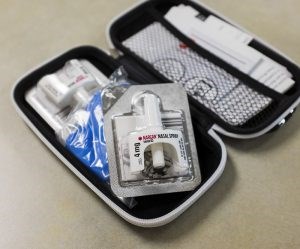Tara Jeffrey
The Sarnia Police Service will begin tracking how often the life-saving drug naloxone is administered by officers on each shift.
“We have some new tracking mechanisms in place where we can actually look at how many doses are given,” said Dep. Chief Julie Craddock at a recent Police Services Board meeting.
“Naloxone is something that we are — on almost, what feels like a daily basis — administering, either through our officers, EMS, fire, or citizens.
“We are dealing with a lot of mental health and addiction issues.”
She pointed to a July incident that involved a male who was given naloxone twice in one day.
“In this instance, [he] had been driving a motor vehicle and struck a hydro pole; luckily it didn’t involve any other citizens at that time,” Craddock noted. “When our officers and EMS arrived on scene, the man was unconscious as a result of an overdose.
“He was administered naloxone, transferred for minor injuries, released, and six hours later we were dispatched to a residence where the same male had overdosed again.”
At that point, he was apprehended as per the Mental Health Act, Craddock explained.
Naloxone is a medication that can temporarily reverse the effects of an opioid overdose and allow time for medical help to arrive.
All front line officers carry naloxone as part of their First Aid kits.
In its most recent Opioid Surveillance Bulletin, released this week, Lambton Public Health points to 22 opioid overdose-related EMS calls in July and 13 opioid overdose-related emergency department visits (compared to 23 EMS calls and nine ED visits in June).
Eleven opioid overdose-related deaths have been reported between January and April of this year for Lambton, though the data is still considered preliminary.
Last month, LPH issued a public health advisory following reports of ten suspected opioid overdoses/toxicity over a five-day period beginning June 29.
Nearly 400 naloxone kits were distributed locally last month, totalling 2,554 this year.
Residents are reminded that the LPH harm reduction program is available Monday-Friday, 8:30 a.m.-4:30 p.m. (closed 12-1 p.m.) to distribute supplies, including naloxone kits.
LPH recommends caution when using opioids or if using drugs not prescribed to you: Don’t mix with alcohol or other drugs Don’t use alone Know the signs of an opioid overdose Carry a Naloxone kit
Signs of an opioid overdose/toxicity include: Difficulty walking, talking, or staying awake Blue or grey lips or nails Very small pupils Cold and clammy skin Dizziness and confusion Extreme drowsiness Choking, gurgling, or snoring sounds Slow, weak, or no breathing Inability to wake up, even when shaken or shouted at.
In the event of a suspected opioid overdose/toxicity: Call 911 and stay at the scene to provide information to paramedics. Administer Naloxone if you have it. Know that the Good Samaritan Drug Overdose Act protects you.Free Naloxone kits are available from Lambton Public Health, local pharmacies, and several partner agencies including Community Health Centres. Residents are reminded to check the expiry date on your naloxone kit and if expired, have them replaced where kits are available.
